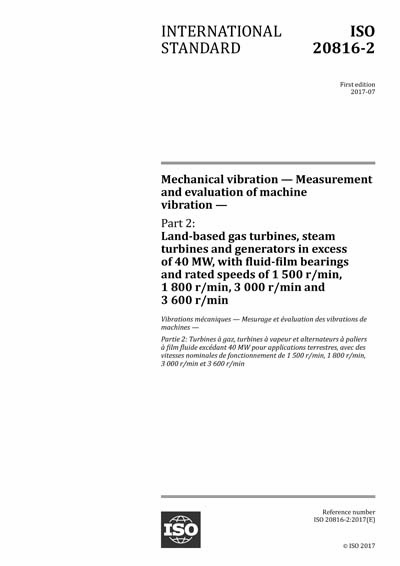Most recent
ISO 20816-2:2017
Mechanical vibration - Measurement and evaluation of machine vibration - Part 2: Land-based gas turbines, steam turbines and generators in excess of 40 MW, with fluid-film bearings and rated speeds of 1 500 r/min, 1 800 r/min, 3 000 r/min and 3 600 r/min
ISO 20816-2:2017 is applicable to land-based gas turbines, steam turbines and generators (whether coupled with gas and/or steam turbines) with power outputs greater than 40 MW, fluid-film bearings and rated speeds of 1 500 r/min, 1 800 r/min, 3 000 r/min or 3 600 r/min. The criteria provided in ISO 20816-2:2017 can be applied to the vibration of the gas turbine, steam turbine and generator (including synchronizing clutches). ISO 20816-2:2017 establishes provisions for evaluating the severity of the following in-situ, broad-band vibration:
a) structural vibration at all main bearing housings or pedestals measured radial (i.e. transverse) to the shaft axis;
b) structural vibration at thrust bearing housings measured in the axial direction;
c) vibration of rotating shafts radial (i.e. transverse) to the shaft axis at, or close to, the main bearings.
These are in terms of the following:
- vibration under normal steady-state operating conditions;
- vibration during other (non-steady-state) conditions when transient changes are taking place, including run up or run down, initial loading and load changes;
- changes in vibration which can occur during normal steady-state operation.
ISO 20816-2:2017 is not applicable to the following:
i) electromagnetic excited vibration with twice line frequency at the generator stator windings, core and housing;
ii) aero-derivative gas turbines (including gas turbines with dynamic properties similar to those of aero-derivatives);
NOTE ISO 3977‑3 defines aero-derivatives as aircraft propulsion gas generators adapted to drive mechanical, electrical or marine propulsion equipment. Large differences exist between heavy-duty and aero-derivative gas turbines, for example, in casing flexibility, bearing design, rotor-to-stator mass ratio and mounting structure. Different criteria, therefore, apply for these two turbine types.
iii) steam turbines and/or generators with outputs less than or equal to 40 MW or with rated speeds other than 1 500 r/min, 1 800 r/min, 3 000 r/min or 3 600 r/min (although generators seldom fall into this latter category) (see ISO 7919‑3 and ISO 10816‑3);
iv) gas turbines with outputs less than or equal to 40 MW or with rated speeds other than 1 500 r/min, 1 800 r/min, 3 000 r/min or 3 600 r/min (see ISO 7919‑3 or ISO 7919‑4 and ISO 10816‑3 or ISO 10816‑4);
v) the evaluation of combustion vibration but does not preclude monitoring of combustion vibration.
International Organization for Standardization [iso]

